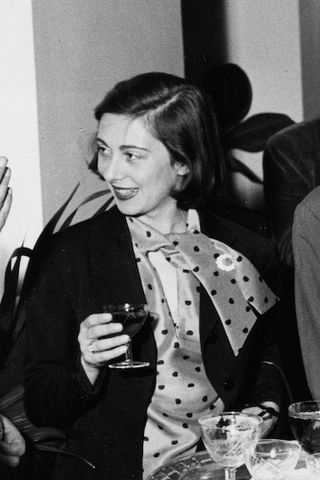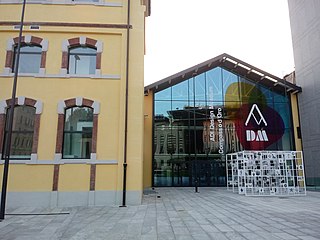Related Research Articles
Alessi is a housewares and kitchen utensil company in Italy, manufacturing and marketing everyday items authored by a wide range of designers, architects, and industrial designers — including Achille Castiglioni, Richard Sapper, Marco Zanuso, Alessandro Mendini, Ettore Sottsass, Wiel Arets, Zaha Hadid, Toyo Ito, Hani Rashid, Tom Kovac, Greg Lynn, MVRDV, Jean Nouvel, UN Studio, Michael Graves, and Philippe Starck. The Alessi company in the UK is worth around £2.4 million.

Mario Bellini is an Italian architect and designer. After graduating from the Polytechnic University of Milan in 1959, Bellini pursued a career as an architect, exhibition designer, product designer, and furniture designer during the Italian economic boom of the late 20th century. Bellini has received several accolades in a variety of design fields, including eight Compasso d'Oro awards and the Gold Medal for Lifetime Achievement by the Triennale di Milano. In 2019, the Italian President of the Chamber of Deputies, Roberto Fico, awarded Bellini a career medal in recognition of his contributions to Italian architecture and design.

The Compasso d'Oro is an industrial design award originated in Italy in 1954. Initially sponsored by the La Rinascente, a Milanese department store, the award has been organised and managed by the Associazione per il Disegno Industriale (ADI) since 1964. The Compasso d'Oro is the first, and among the most recognized and respected design awards. It aims to acknowledge and promote quality in its field in Italy and internationally, and has been called both the "Nobel" and the "Oscar" of design.

Alessandro Mendini was an Italian designer and architect. He played an important part in the development of Italian, Postmodern, and Radical design. He also worked, aside from his artistic career, for Casabella, Modo and Domus magazines.

Achille Castiglioni was an Italian architect and designer of furniture, lighting, radiograms and other objects. As a professor of design, he advised his students "If you are not curious, forget it. If you are not interested in others, what they do and how they act, then being a designer is not the right job for you."

Richard Sapper was a German industrial designer who was based in Milan for much of his career. He is considered to be one of the most influential figures of post-war Italian design. His products typically feature a combination of technical innovation, simplicity of form, and an element of wit and surprise.
Antonio Citterio is an Italian architect, furniture designer and industrial designer who lives and works in Milan.

Marco Zanuso was an Italian modernist architect and designer.

Maria Cristina Mariani Dameno, known as Cini Boeri, was an Italian architect and designer. She was considered "one of the great pioneering women in Italian design and architecture", who was described as a "formidable architect and designer, paragon of Milanese elegance and verve."

Franco Albini was an Italian Neo-Rationalist architect, designer and university instructor in design.
In Italian design, the Radical period took place in the late 1960s, with a shift in style among the avant-garde. Probably the most notable result of this avant-garde period is the installation called "Superarchitettura", made in Pistoia in 1966. Another important exhibition dedicated to radical design in Italy was held at MoMA in 1972.

Angelo Mangiarotti was an Italian architect and industrial designer. His designs were mostly for industrial buildings and railway stations. In 1994 he received the Compasso d'Oro award of the Associazione per il Disegno Industriale for his lifetime of achievement.

Giulio Cappellini is the founder and art director of the eponymous Italian furniture company Cappellini based in Milan. In 2004 the Company became part of the Poltrona Frau Group. In 2021, it was acquired by the American office furnisher Haworth Inc.
Roberto Pezzetta is an Italian artist and industrial designer.

Emilio Ambasz is an Argentinian-US architect and award-winning industrial designer. From 1969 to 1976 he was Curator of Design at the Museum of Modern Art, in New York. Ambasz has been labeled as "the father, poet, and prophet" of the green architecture by Japanese architect Tadao Ando.
Atelier Mendini is a design and architecture studio based in Milan, Italy. It was founded in 1989 by two architect brothers Alessandro and Francesco Mendini. The Atelier consists of various design professionals: including architects, graphic designers, and industrial designers. It also has a special department dedicated to project research and experimentation in materials.
Michele de Lucchi is an Italian architect and designer.

Zanotta is an Italian furniture company particularly known for the iconic pieces of Italian design it produced in the 1960s, 70s, and 80s. These include the "Sacco" bean bag chair and "Blow", the first mass-produced inflatable chair. The company was founded in 1954 and has its main plant in Nova Milanese. In 1984 Zanotta established its experimental division, Zabro, headed by Alessandro Guerriero, with Alessandro Mendini and Stefano Casciani. Since the death of its founder, Aurelio Zanotta, in 1991, it has been run by members of his family. Zanotta's products were awarded the Compasso d'Oro in 1967, 1979, 1987 and 2020.

Andrea Branzi was an Italian architect, designer, and academic. He was born and raised in Florence, though he lived and worked in Milan for much of his career. He was a professor and chairman of the School of Interior Design at the Polytechnic University of Milan until 2009.

The ADI Design Museum is a museum in Milan, Italy, which houses the historical collection of the ADI Compasso d'Oro Foundation, as well as temporary exhibitions, public talks and initiatives. It is dedicated to the understanding and promotion of design in Italy and abroad.
References
- ↑ Sato, Kazuko,Alchimia, Rikuyo-sha Publishing, Inc., 1988, ISBN 3892680337
- ↑ "Studio Alchimia". www.domusweb.it. Retrieved 2024-08-15.
- ↑ Bruno Gregori/ Bio. Laurameroni.com. Retrieved 28 July 2019.
- ↑ Alessandro Guerriero: Tre Momenti di Phantasia. Website of Alessandro Guerriero. Retrieved 2019-04-12.
- ↑ Alchimia Milano/ collaborazioni. Alchimia website. Retrieved 2019-04-12.
- ↑ Elogio Del Banale. Published for the exhibition "L'Oggetto Banale" at Venice Biennale 1980, curated by Barbara Radice. Retrieved 23 July 2019
- ↑ Syson, Damon (23 September 2011). "Postmodernism: Style and Subversion 1970-1990". Wallpaper*. Retrieved 17 October 2018.
- ↑ Ward, Ossian (30 November 2011). "Postmodernism: Style and Subversion, 1970-1990". Art in America. Retrieved 17 October 2018.
- ↑ XII edizione Premio Compasso d'Oro. ADI – Associazione per il Disegno Industriale. Retrieved 23 July 2019.
- ↑ "DESIGN RESEARCH". ADI Design Museum. Retrieved 2024-08-15.